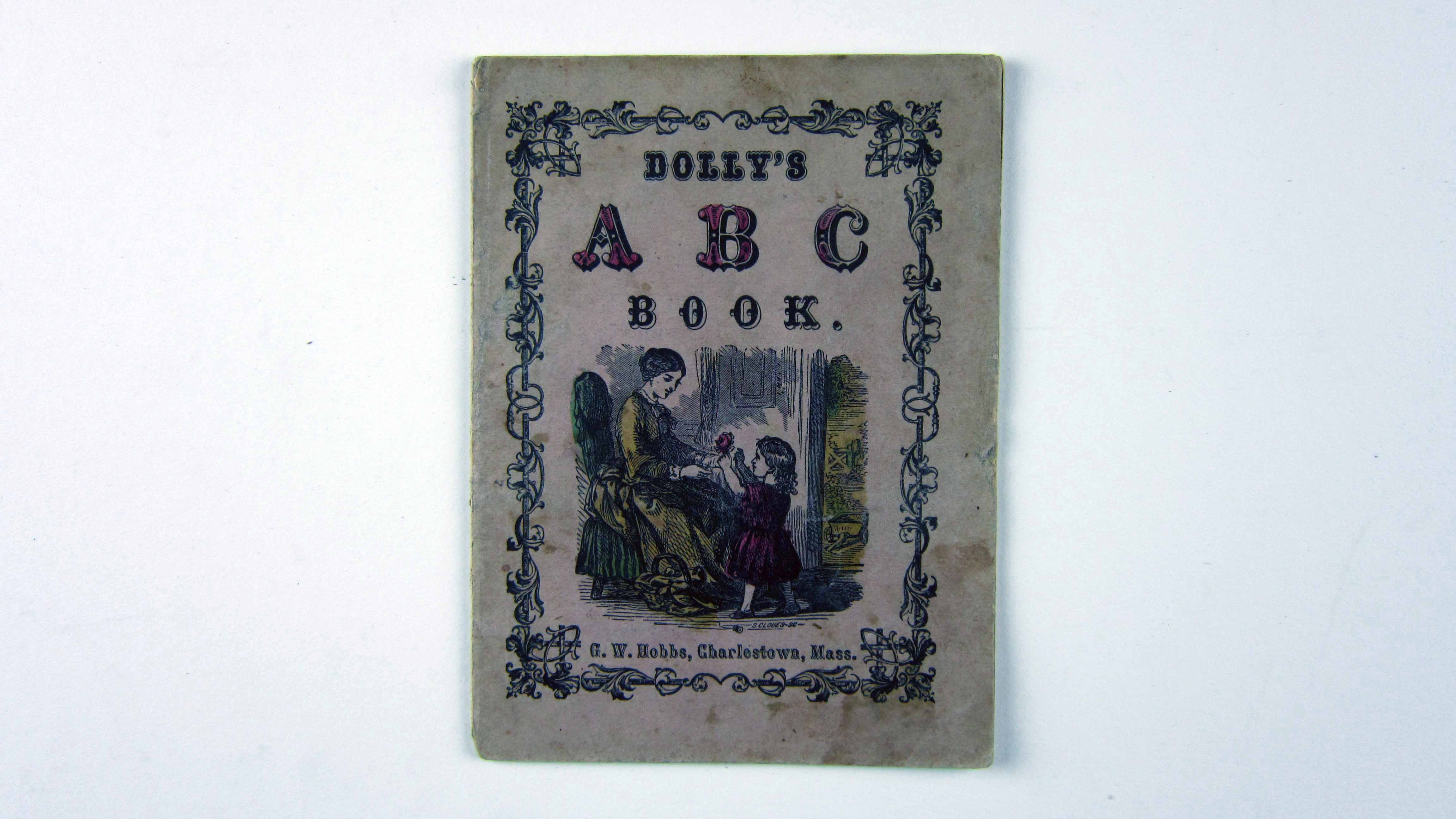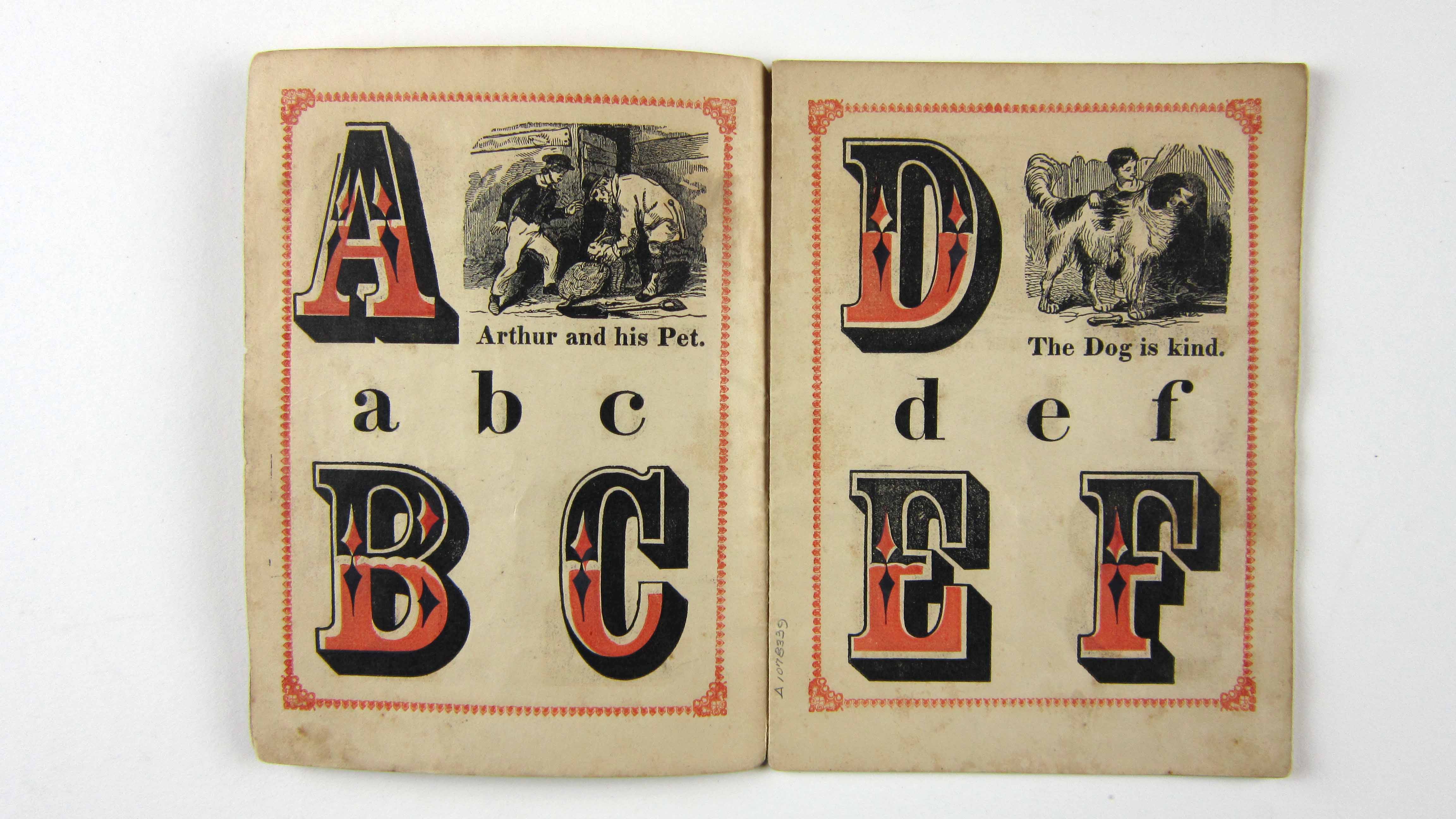

Alphabet books offer a vivid insight into the history of literacy and culture, as well as concepts of childhood. The Children's Book Collection at UCLA contains a rich array of these materials, some well-worn and much-used, some still bright and fresh. Each is a gem of print production and graphical imagery from another time and place. Though the history of alphabet books continues to the present, this exhibit focuses on the works in our collections published between 1700 and 1900, including horn books, primers, works of didacticism and seriousness, whimsy and play.
2. A Jumble ABC
3. A Little Pretty Pocket-Book
4. A New Lottery Book of Birds And Beasts
5. A Pretty Play-Thing for Children of All Denominations
8. ABC of Objects for Home And School
10. ABC with Pictures & Verses
12. Alphabet Et Instruction Pour Les Enfans
16. Dolly's ABC Book
17. Flora's ABC
18. Home ABC
22. Hornbook C. 1700
23. Large Letters for the Little Ones
24. Little ABC Book
25. Little People: An Alphabet
26. Martin's Nursery Battledoor
27. Mother Goose ABC
28. My Darling's ABC
29. Orbis Sensualium Pictus Quadrilinguis
30. People of All Nations: A Useful Toy for Girl Or Boy
31. Picture Alphabet
32. Pretty ABC
33. Railway ABC
34. Rusher's Reading Made Most Easy
38. The Alphabet of Old Friends
40. The Amusing Alphabet for Young Children Beginning To Read
42. The Child's Christian Education
45. The Easter Gift
47. The Favorite Alphabet for the Nursery
49. The Franklin Alphabet And Primer
51. The Golden ABC
55. The Moral And Entertaining Alphabet
57. The Old Testament Alphabet
59. The Picture Alphabet for Little Children
62. The Sunday ABC
63. The Union ABC
64. The Young Child's ABC, Or, First Book
65. Tom Thumb's Alphabet: Picture Baby-Books
67. Warne's Alphabet And Word Book: with Coloured Pictures
68. Wood's Royal Nursery Alphabet
Title Dolly's ABC Book


Brief description Chapbook slightly larger than the length of an adult hand. Alphabet letters printed in black and red, ornamental border around text printed in red.The book epitomizes the maternal, idealistic nature of children's literature in the 1850s.
Full description Dolly's ABC Book is a chapbook from 1854 that is slightly bigger than the length and width of an adult hand. This book is a model of mid-nineteenth century alphabet books with its use of idealism, farmyard animals, and motherhood as a gateway to literacy.
Childhood is utterly romanticized in this book: children play in nature, live and communicate harmoniously with animals, and delight in their toys. Animals are loyal, siblings a pleasure, and parents doting.
Cultural imagery and gender roles are prevalent in Dolly's ABC Book. The little girls, though adventurous and outdoorsy, are seen mothering their dolls and preparing food. The boy is shown protecting his mother and sisters from a snake and playing outside while the girls watch in the background. The mother is shown on the cover illustration as serene and authoritative in a high-backed chair while the little girl brings her a rose. This image of the sanctified mother is ubiquitous in the literature of this time period, revealing the hallowed position that mothers held in Victorian culture.
The vignettes of active and well-behaved boys and girls are done in woodcut illustrations and support the text accompanying the alphabet.
Literacy Dolly's ABC Book was printed in 1854 to meet the interests of a growing middle class and support the demands for widespread literacy. Social changes brought about by the Industrial Revolution had created a drive to educate more people to meet the need for skilled workers to run complicated machinery and do office work. Compulsory public education was becoming widespread.
By the mid-nineteenth century, employers were starting to see the value of an educated workforce. Literacy, defined as the ability to read and write, was a means to create skilled workers who were "training in being trained." Yet another trend that had contributed to an uptick in literacy in the 1850s was the explosion of Noah Webster's dictionaries. Produced in the early 1800s, by 1854 the dictionaries had became commonplace in every home in America, standardizing spelling and word usage.
Childhood The child of Dolly's ABC Book exists in a maternal world teeming with wonder and emotion. The child's inner world is evident in sentences such as "John is frightened" and "John is shouting in his joy." This represents a shift in attitudes toward children who are now seen in the nineteenth century as having their own personalities and experiences.
Childhood in Dolly's ABC Book is idealized and romanticized. Children are shown playing harmoniously with one another and nature. Mothers are kind, competent, and delighted in their children. The maternal influence is clear in Dolly's ABC Book. The prototypical illustration of the little girl bringing a flower to her smiling mother in a high-backed chair is representative of the new role women play in education and literacy.
The one unpleasant depiction in Dolly's ABC Book is of a boy named John frightened of the snake, but even that image reinforces the bravery of boys as he protects his mother and sisters. Dolly's ABC Book epitomizes Rousseau's belief in intimacy between mother and child, the importance of children in nature, and the importance of practical education - e.g. "What a pleasure [John] must feel, as he views his new-made toy!"
Iconography Dolly's ABC Book embodies many of the hallmarks of mid-nineteenth century children's literature including idealism, the use of animals, and the sanctification of motherhood.
The idealistic images of children playing joyfully in nature reflect the new notion of childhood as a time for adventure and play. Kind and loyal animals populate the pages of Dolly's ABC Book from "Old Rover," the kind and faithful dog, to the delightful talking parrot.
Like most children's literature before the late twentieth century, the characters in Dolly's ABC Book are all white and are stratified by gender. In one picture we see an older sister "mothering" a baby sister and in another a girl preparing food. When a snake frightens John, the brother, you still see him in front of his sister and mother, protecting them from danger.
One cultural difference that can be seen as positive in Dolly's ABC Book is that the children are active and lifelike. Whereas previous children's books portrayed children as doll-like and insipid, the children in this book are vibrant and emotional; a departure that reflects the relatively modern view of children as individuals with inner lives, not merely miniature adults.
Production Dolly's ABC Book was published by G.W. Hobbs in Charlestown, Massachusetts around 1854. G.W. Hobbs published other children's books as well, such as The Little Keepsake, the Tiny Storybook, Little Verses for Little Girls, The Little Reward, and White Violets.
The printing and production are similar in all of these books. G.W. Hobbs even used some of the same woodcut illustrations in several of his children's books. For instance, The Little Keepsake has the same woodcut illustration of a girl rowing a boat and the same ornamental border as Dolly's ABC Book.
In Dolly's ABC Book the alphabet letters are printed in black and red, and the wood-engraved cover illustrations are black, red, green and yellow. These same four colors are used in several of G.W. Hobbes' books. The bulk of G.W. Hobbes' printing was for children, evidence of the growing children's book market in the latter half of the nineteenth century.
Publisher G.W. Hobbs
Publication place 11 N. Sixth Street, Charlestown
Date 1854
UCLA Call Number CBC PE1119.A1 D65 1854
Repository UCLA Charles E. Young Research Library, Dept. of Special Collections
Dimensions 17 cm height
Technologies of production Color wood engravings
Media and Materials Alphabet letters printed in black and red, ornamental border around text printed in red
Additional Information Inscription in pencil on recto of leaf [1], with date in blue pencil: 186[3?]
Caption